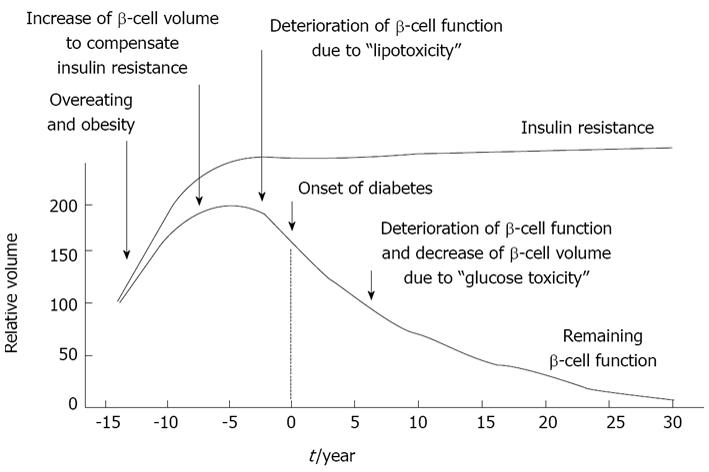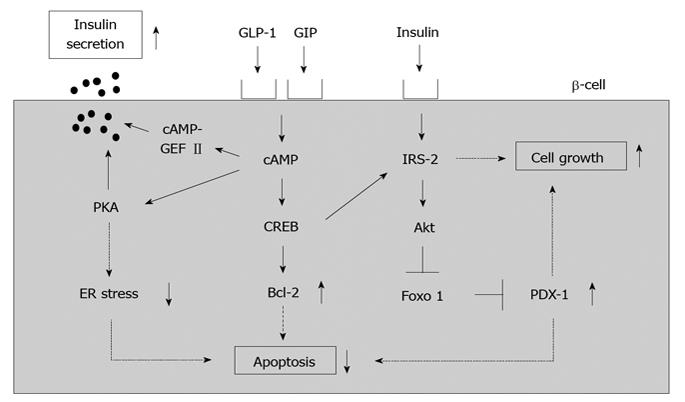Copyright
©2013 Baishideng Publishing Group Co.
World J Diabetes. Dec 15, 2013; 4(6): 263-269
Published online Dec 15, 2013. doi: 10.4239/wjd.v4.i6.263
Published online Dec 15, 2013. doi: 10.4239/wjd.v4.i6.263
Figure 1 Typical progress of type 2 diabetes.
The development of type 2 diabetes is associated with pancreatic β-cell dysfunction and insulin resistance. First, overeating and/or obesity lead to the development of insulin resistance and normal β-cells secrete a larger amount of insulin to compensate for the increased insulin resistance. Next, large adipocytes secrete a larger amount of free fatty acids and/or various inflammatory cytokines which gradually deteriorate β-cell function and finally lead to the onset of diabetes. This process is known as “β-cell lipotoxicity”. Once hyperglycemia becomes apparent, β-cell function progressively deteriorates; insulin biosynthesis and secretion are reduced. This process is known as “β-cell glucose toxicity” which is often observed in type 2 diabetes.
Figure 2 Possible molecular mechanism for suppression of insulin biosynthesis in type 2 diabetes.
Under diabetic conditions, hyperglycemia induces oxidative stress and thereby leads to suppression of insulin biosynthesis and secretion which is accompanied by reduction of nuclear pancreatic duodenal homeobox 1 (PDX-1) and MafA expression. Oxidative stress and subsequent activation of the JNK pathway translocate Foxo1 from cytoplasm to nuclei, leading to translocation of PDX-1 from nuclei to cytoplasm in β-cells. In addition, oxidative stress and subsequent induction of c-Jun expression suppress nuclear expression of MafA in β-cells. Therefore, it is likely that induction of oxidative stress and suppression of nuclear PDX-1 and MafA expression are involved in β-cell glucose toxicity found in type 2 diabetes.
Figure 3 A role of incretin signaling in pancreatic β-cells.
Incretins (GLP-1 and GIP) bind their incretin receptors (GLP-1 and GIP receptors) in β-cells and increase intracellular cAMP levels, leading to stimulation of insulin secretion, suppression of β-cell apoptosis and increase of β-cell growth.
Figure 4 Down-regulation of incretin receptors in pancreatic β-cells under diabetic conditions.
Under diabetic conditions, expression of incretin receptors (GLP-1 and GIP receptors) in β-cells are down-regulated, leading to decrease of insulin secretion, increase of β-cell apoptosis and decrease of β-cell growth.
- Citation: Kaneto H, Matsuoka TA. Down-regulation of pancreatic transcription factors and incretin receptors in type 2 diabetes. World J Diabetes 2013; 4(6): 263-269
- URL: https://www.wjgnet.com/1948-9358/full/v4/i6/263.htm
- DOI: https://dx.doi.org/10.4239/wjd.v4.i6.263












